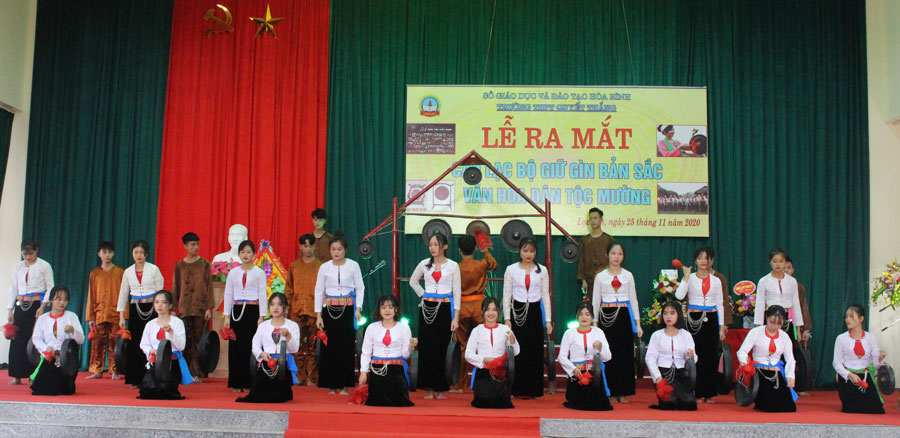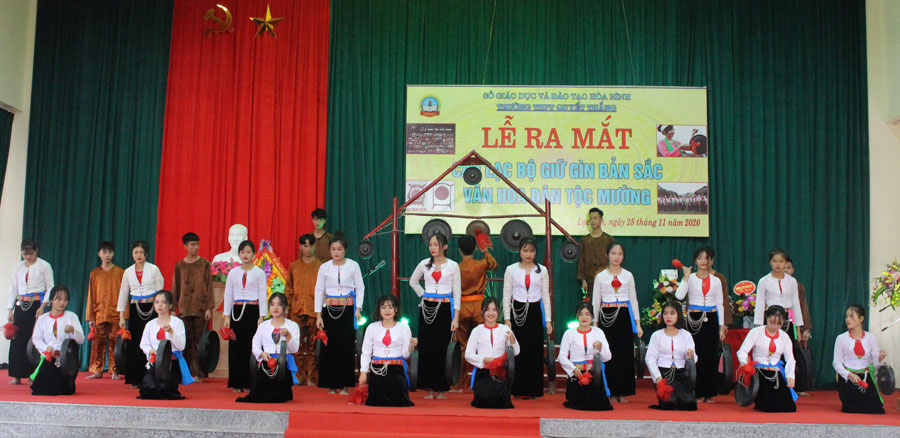
(HBO) - In November 25th, Quyet Thang High School (Lac Son district) held a launching ceremony of the club preserving and promoting the cultural identity of the Muong ethnic group.
 A special gong performance of the students
at the opening ceremony of the Club preserving and promoting the cultural
identity of the Muong ethnic group.
A special gong performance of the students
at the opening ceremony of the Club preserving and promoting the cultural
identity of the Muong ethnic group.
The club preserving and promoting the
cultural identity of Muong ethnic people was born to preserve and promote the
national cultural identity. It creates a "playground” for the cultural and arts
exchange for the school's staff, the teachers and the students. It helps to
train students' life skills as well as to promote the spirit of solidarity and
encouragement for the staff, the teachers and the students to observe the
undertakings and policies of the Party and the laws of the State. It also helps
to build a cultural environment in the school, contributing to building a rich,
beautiful and civilized homeland, and to retaining the beauty in the nation's
culture as well.
At the launching ceremony, the students
performed some outstanding performances such as: The concert of the musical
instruments, the concert of Muong gongs, performing the medley of U hay and Dap
nang Khot, exchanging Dum singing, introducing the cuisine of Muong ethnic
peopel, performing the costumes of Muong ethnic groups and so on.
With an increasingly vibrant and widespread emulation movement aimed at building cultured residential areas and cultured families, Yen Thuy District has been making steady progress toward improving both the material and spiritual well-being of its people, while fostering a civilized, prosperous, beautiful, and progressive community.
Once lacking recreational spaces and community facilities, Residential Group 2 in Quynh Lam Ward (Hoa Binh City) has recently received attention for the construction of a new, spacious, and fully equipped cultural house. The project followed the model of state support combined with public contributions in both labor and funding.
The "All people unite to build cultural life" movement, which has been effectively integrated with Kim Boi district’s socio-economic development goals, is fostering a lively spirit of emulation across local residential areas, hamlets, villages, public agencies, and enterprises. In addition, through the initiative, traditional cultural values are being preserved and promoted, while community solidarity and mutual support in poverty reduction and economic development are being strengthened.
A working delegation of the Hoa Binh provincial People’s Committee led by its Permanent Vice Chairman Nguyen Van Toan on June 11 inspected the progress of a project to build the Mo Muong Cultural Heritage Conservation Space linked to tourism services in Hop Phong commune, Cao Phong district.
Born and growing in the heroic land of Muong Dong, Dinh Thi Kieu Dung, a resident in Bo town of Kim Boi district, in her childhood was nurtured by the sweet lullabies of her grandmother and mother. These melodies deeply imprinted on her soul, becoming an inseparable part of her love for her ethnic group's culture. For over 20 years, this love for her hometown has driven Dung to research, collect, and pass down the cultural values of the Muong people to future generations.
In the final days of May, the Ethnic Art Troupe of Hoa Binh Province organized performances to serve the people in remote, mountainous, and particularly disadvantaged areas within the province. These were not just ordinary artistic shows, but they were the meaningful journeys aimed at spreading cultural values, enhancing the spiritual life of the people and contributing to the preservation of ethnic minority cultural identities.



 A special gong performance of the students
at the opening ceremony of the Club preserving and promoting the cultural
identity of the Muong ethnic group.
A special gong performance of the students
at the opening ceremony of the Club preserving and promoting the cultural
identity of the Muong ethnic group.